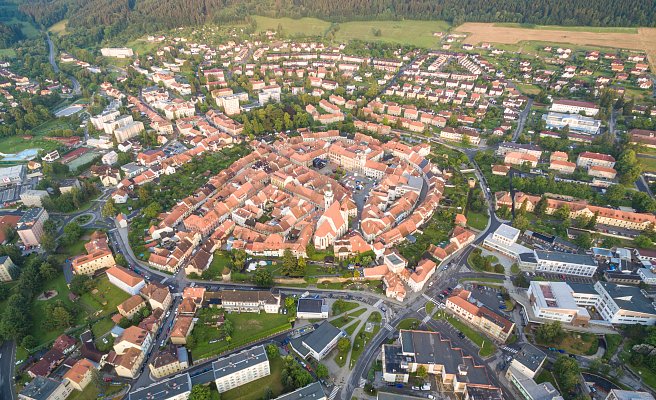
The historical town of Prachatice, also called the “gateway to the heart of the Šumava Mountains” or the “pearl on the Golden Path,” was founded at the turn of the 13th and 14th centuries. The historical core of the town, which was declared a town heritage reservation in 1981, consists of a ring of double city walls (which were needed due to frequent raids) and Renaissance houses on the square and in adjacent streets. The town received the “Historical Town of 2002” award.
Prachatice was granted the right to store salt in 1382, which meant that other towns had to buy salt from Prachatice and this made the town very prosperous. It was the Habsburgs who ordered salt to be imported from Austria and the famed Golden Path was closed. However, the town’s economy was supported by the activities of traders with packhorses (German: Säumers) who worked at the request of the nobility, for many years. You can find out more about them in the interactive exhibition in the municipal museum. Thanks to the Golden Path, Prachatice became a royal town and flourished with wealth and splendid houses, the original beauty of many of which has been preserved. The square is decorated with a fountain with the statue of Justice and a modern sculpture of an ancient bicycle.
The most prominent Renaissance monument is the Old Town Hall decorated using the chiaroscuro technique. The paintings below the roof ledge depict the eight human virtues: patience, caution, love, justice, faith, hope, bravery and temperance. The new Town Hall dates back to 1903 and is decorated with oblong sgraffiti under the windows depicting a packhorse caravan on the way from Passau to Prachatice. A statue of the patroness of the town of Prachatice is set in a niche, and the facade is also decorated with statues of a merchant and a landsknecht.
The so-called Golden Path intersected the southern part of Bohemia and the Danube Region from the Middle Ages and had three basic branches: one branch passed through Prachatice, another through Vimperk and the third one through Kašperské hory to Passau, terminating in Salzburg. It was an example of communication that brought life to the vast regions of neighbouring medieval states: the Bishopric of Passau and the Bohemian Kingdom. It was used not only to transport commodities but also brought the ideas and culture of colonists who settled and brought life to the inhospitable border forests.
It is worth seeing the interactive exhibition of the Golden Path in Renaissance House No. 10 in the Prachatice Museum, which also includes engravings by Jaques Callot that show the hardship of the Thirty Years' War.
Did you know that … according to legend, there is an imprint of the face of young Jan Hus in the rock close to Husinec? When returning from school to Staré Prachatice, he used to sit under a rock in the valley of Blanice River, which is now the Husinec Dam Reservoir.
Our tip:
Climb up the observation tower, which is part of the Late Gothic Church of St. James the Great on Kostelní náměstí between Velké náměstí and the Lower (Písek) Gate. The gate is open daily from June to September.
Natives and notables:
- Jan Hus (1370–1415) – a medieval reformer, a Catholic priest and preacher, a university rector; he went to school in Prachatice and lived in a small room on the first floor of the house, which is now the municipal library (today’s Husova Street).
- Jan Nepomuk Neumann (1811–1860) – a Prachatice native who became the second American saint in 1977. He went on a mission to the USA and had 80 churches and over 100 parish schools built in Baltimore. He is considered the founder of American Catholic education. He visited his native Prachatice for several days in 1855.